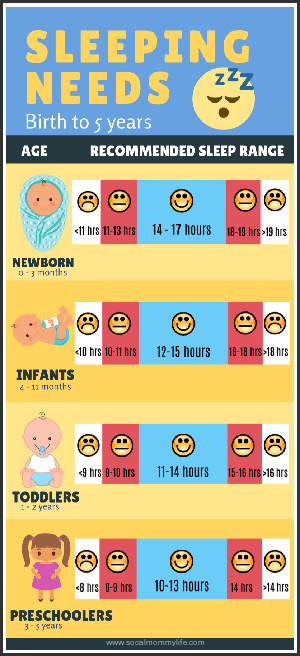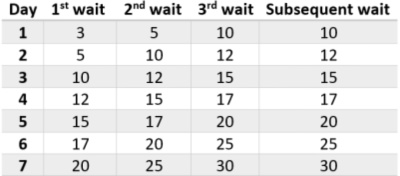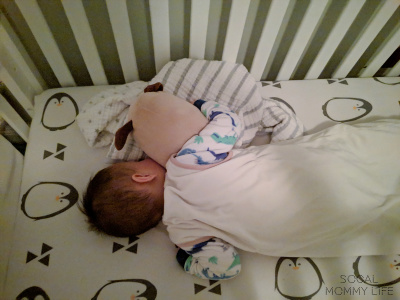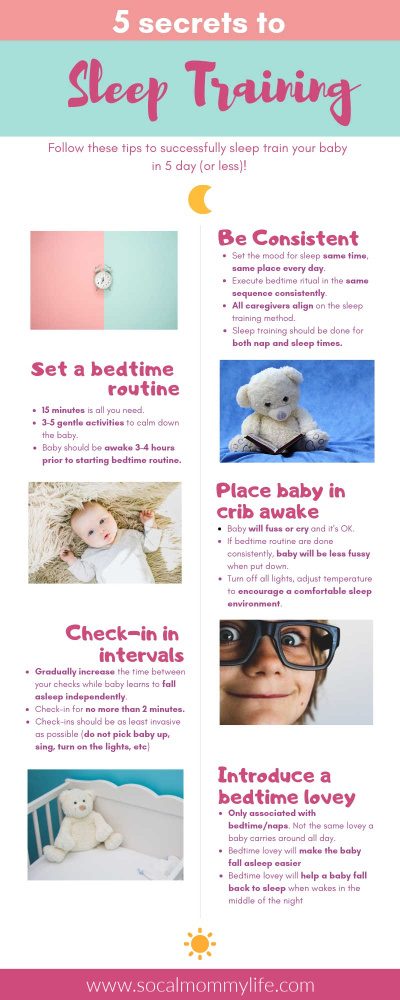People who say they sleep like a baby usually don’t have one
Leo Burke
Like 99% of new moms, I was sleep-deprived. I became sick and tired of having to rock my 6-month-old son in my arms for an hour before he dozed off. Baby Chunbao didn’t have any routines whatsoever. He slept whenever and however long he wanted. At about 6-month postpartum, I was exhausted and eager to get sleep training underway.
I researched and learned helpful tips from therapists and friends. After deciding on a sleep training program and carry through with lots of patience, we were able to sleep train our 6-months-old baby in 5 days! We have found key success factors that worked for us so I’m here to share that experience with you.

What is sleep training?
Sleep training is the process of helping a baby fall asleep on his own. A sleep-trained baby can sleep through the night and can fall back to sleep after he awakens in the middle of the night all on their own.
Now, sleep training doesn’t necessarily mean that the child sleeps in his own room. A sleep-trained child can co-sleep or sleep in the same room as his parents. A sleep-trained child can fall asleep and stay asleep without other’s help even if he is sleeping on the same bed as his parents.
If you want to know how to make your child sleep alone, check out this useful article here.
Why is sleep training so important?

Most babies do not have the ability to fall and stay asleep in an organized pattern, although they inherently need to do so. It is our job to sleep train and bring much-needed structure into our family’s lives. After all, who wants to spend hours soothing a child to sleep and then be woken up again a few hours later?!
Research has shown that adequate sleep duration on a regular basis leads to improved attention, behavior, learning, memory, emotional regulation, quality of life, and mental and physical health.
If you are unsure how many hours your baby needs to sleep in a day (including daytime naps), refer to the following sleeping needs guidelines from the National Sleep Foundation:
Sleep training your baby can help your whole family get some much-needed nighttime sleep so that you can focus on the things that matters most!
At 9-months-old, Baby Chunbao goes down at 7:30 pm and I am able to accomplish so much before I go to bed – prepping for tomorrow’s meals, read a book, watch a movie, and have a bubble bath with wine!
When should I start sleep training my baby?
Sleep training can begin as early as 4 months, with the pediatrician’s approval. Usually, the doctor will assess your baby’s health to see if she is ready to skip the night feeding. Keep in mind that the goal of sleep training is to have your baby sleep through the night, thus no more middle of the night feedings!
Before getting started with sleep training, make sure:
- Your baby doesn’t have medical conditions such as fever, reflux and cutting teeth, that may keep your baby awake at night.
- You and all caregivers are committed and agree on the sleep training methodology.
- You are ready to skip night nursing/feedings. If you nurse 5 times in the middle of the night. You should be prepared to nurse your baby only once before bed then not again until morning.
- No travel plans for at least 2 weeks. Differences in sleep environment and time zones can make sleep training difficult.
What is the best sleep training method?
There are many approaches to sleep training with varying degrees of crying. Since every baby and parenting style is unique, there is really no one-size-fits-all solution to sleep training.
The best sleep training method is the one that fits your family and your baby’s needs.
However, since we are talking about sleep training your baby within a short period of time (as short as 5 days), I have found that the check-and-console method has worked well with most babies. You get to see results sooner (compared to lesser tear methods) and less “harsh” on the baby (compared to the Cry It Out method).
This sleep training method is simple.
First, lay your baby in his crib drowsy and leave the room. When he starts to cry, go in and check on him. Do not pick him up! Gradually increase the time between your checks, allowing your baby more and more time to learn to self-soothe and fall asleep independently.
You can learn more about the Ferber sleep training method and download a FREE sleep training worksheet here.
We were able to sleep train Baby Chunbao in a few days with this method. Below are 5 tips that have made our sleep training journey a pleasant ride.
This post may contain affiliate links, which means I’ll receive a commission if you purchase through my link, at no extra cost to you. Please read full disclosure here.
5 secrets for success in sleep training
Secret #1: Be consistent (and persistent!)
This is the first on the list because this is the most important step in sleep training your baby. Be consistent means that you do the same things the same way over time.
Here is what consistent means in terms of sleep training:
- You set the mood for sleep at the same time, in the same place every day.
- The bedtime ritual discussed below is executed in the same sequence consistently.
- You and whoever else involved in the sleep training process must be in total alignment in your determined methodology, including nap and sleep times.
Let me delve a bit further into the last bullet point because this is where I see the most broken links. If mommy lets the baby cry for 5 minutes before she went in to check on her and dad decides to pick the baby up the second she cries, that’s inconsistency. Another example is that both parents do the cry it out method at night and the nanny lets the baby fall asleep in her arms, that’s inconsistency.
So why is being consistent in every aspect of sleep training so important?
Sleep training is a learned skill and it takes practice to be good at it. Let’s say your child is learning how to speak English. If you teach her with an American accent and the next day, someone teaches her with a British accent, would she be confused? You are sending mixed messages to your baby that’ll hinder her from learning to fall asleep sooner. Consistency is key.
We had a 24-hour nanny who came to our house Sunday nights and leave Friday nights. She even sleeps in the nursery (in her own bed of course). She always rocks baby Chunbao to sleep and picks him up the moment he cries. Her actions are understandable because a nanny’s job is to make a baby happy.
However, this backfired when we started to sleep train our baby.
The inconsistency made it impossible for us to sleep train baby Chunbao. It was not until our nanny left months after we started the sleep training process that baby Chunbao became self-sufficient in putting himself to bed.
You and whoever else involved in the sleep training process must be in total alignment in your sleep training method, including nap and sleep times.
Being persistent is just as important as being consistent in sleep training your baby. Simply put, don’t give up. How long it takes to sleep train a baby varies from family to family. Just like learning to ride a bike varies from person to person.
Secret #2: Set a bedtime routine
Now that you know how important it is to be consistent, setting a bedtime routine prepares the baby to sleep so that when you are done with the last routine, the baby knows that it’s time to sleep.
15 minutes is all you need.
A bedtime routine should consist of short, simple and soothing activities that calm down the baby after a day of rowdy play. It is best if each activity becomes more and more gentle as they progress.
Here are some examples of bedtime routine activities, in the order of gentleness:
- Sing and dance along with her favorite song
- Bounce on your legs or in the bouncer
- Play with sensory balls or gentle games like stacking blocks and peekaboo
- Bath
- Massage with baby-safe massaging oil
- Read a bedtime book together
- Rock on the glider
- Sing a lullaby
- Nurse or bottle feed
- Say good-night
Some bedtime routines consist of all the above activities while some only have 3. The point here is to engage in activities that your baby enjoys but not to get her too excited. If your baby doesn’t like baths, don’t incorporate it in your routine. Babies don’t need daily baths anyways. Also, if activities like playing peekaboo get your baby too excited, don’t make it a daily ritual as well.
To start, select 4-5 activities that you’re committed to doing every day with your baby. You can always reduce the more she is sleep trained.
When I first started sleep training baby Chunbao around 6 months old, our bedtime ritual consists of bathtime, read books, nurse, lullaby, and a kiss-good-night. Around 10 months old, we did bathtime, bottle feed, and a kiss-good-night. Now at 1 year and a half, he sleeps when it’s time to sleep (usually around 7:30 pm)!
Some parents find that white noise helps a baby fall asleep faster so do some trial and error to see if it works. You can invest in one like this or use an app on your smart device. Our humidifier produces a low, soft tone that happens to be a trance for baby Chunbao. Talking about killing two birds with one stone!
What to know what are the must-haves for sleep training?
![]() This article has everything you need to successfully sleep train your baby in no time!
This article has everything you need to successfully sleep train your baby in no time!
Be conscious that before you start the bedtime routine, your baby should be awake for an appropriate amount of time between 3-4 hours. An over- or under tired baby will have trouble falling asleep.
Secret #3: Place baby in the crib awake
After you have completed the bedtime routine, your baby should be drowsy. If not, proceed to leave him in the crib to start the sleep training process. As you consistently do the bedtime routine, your baby will learn that it’s time for bed after you have completed the routine and will be less fussy when you put him down.
Secret #4: Check-in on your baby in timed intervals
At first, your baby may fuss or cry when you leave the room. Wait about 3 minutes and check-in to console her. Leave the room after 2 minutes tops. Your baby may still be crying and that’s ok.
For the 2nd interval (or wait), go in after 5 minutes and console her for no more than 2 minutes. Your baby may still be crying.

On the 3rd wait, go in after 10 minutes and console for no more than 2 minutes. From there, you would gradually increase the time between your checks, allowing your baby more and more time to learn to self-soothe and fall asleep independently.
Your plan for check-ins may look similar to this chart.
This plan for check-ins can be adjusted according to your baby’s needs. You can increase your wait time if frequent check-ins are too overstimulating to your baby. You can also keep the same check-in schedule for a couple of days if your baby needs more time to fall asleep.
Important things to keep in mind when checking in on your baby:
- Do not turn on the lights. Bright lights may overstimulate your baby.
- Do not pick your baby up, rock, swing, or sing.
- Console for no more than 2 minutes. Bring a timer with you, if needed.
- Use very gentle consoles like patting on the butt, rub on the back, stoke on the head, or whisper shhh.
- If your baby wants to roll over or stand up, gently place him on the side he prefers to sleep on
Remember that your goal is to train your baby to fall asleep by herself. Your check-ins should be as least invasive as possible.
Secret # 5: Introduce a bedtime lovey
If your baby already has a bedtime lovey, great! If not, please do not skip this step.
A bedtime lovey is a comfort object a baby brings to bed. This is not the same as a lovey a baby carries around all day. You only want a bedtime lovey for your baby so that he associates it with sleep. A bedtime lovey is usually soft and cuddly, like a small teddy bear, soft washcloth, throw pillow, blankie, etc.
Here are some highly-rated bedtime loveys for babies![]()
A bedtime lovey will make the baby fall asleep easier once he makes the lovey-sleep association.
How do you introduce a bedtime lovey? The act of just placing the lovey next to your sleepy baby will help him make the association that the lovey is for sleep. The key here is once again, be persistent!
Baby Chunbao never had a lovey. In fact, we received a few blankies and teddies from friends but he never showed interest in them. He was about 7 months old at that time. Research shows that comfort aids play a crucial role in sleep training so I gave my son a teddy dog only for bedtime. He didn’t budge at first. One day, a few days after he was sleep trained, he reached for his teddy and fell asleep in his crib!

A lovey can also help a baby fall back to sleep when she wakes in the middle of the night. Instead of looking for mommy in the middle of the night, a lovey will provide the baby comfort and help them fall back to sleep.
I have witnessed multiple times through our baby monitor that when baby Chunbao woke up in the middle of the night screaming, probably from a nightmare, he grabbed his teddy and fell right back to sleep.
Co-Sleeping and sleep training
I highly, highly recommend having a separate nursery for your baby. In simple terms, do not sleep in the same room as your baby.
During the process of sleep training, the baby is learning to fall asleep on her own. In the first couple of nights, she will wake up in the middle of the night looking for comfort. If she sees mommy or daddy (trust me she knows someone’s there even with the lights off) she’ll get up and cry. This is the reason I’m not a believer in co-sleeping.
For some, it is a luxury to have an extra room for the baby but you can always be creative here. A converted walk-in closet, a corner in the office, a nook in the master bedroom can all be tucked with a crib.
Check out some creative bedroom sharing ideas with your baby here.
Final thoughts on sleep training your baby
Be flexible about how you apply your sleep training method and carefully observe how your baby reacts. Sleep training is not as stressful as most parents think. Know that your baby will be sleep trained if you are consistent in putting the efforts!
Now you have everything you need to get started with sleep training.
Before you get started with sleep training your baby, be sure to leave a comment below to let me know what you think of these 5 simple steps to get your baby sleep trained.
Baby sleep training related articles
- 5 Tips on Sleep Training With the Ferber Method
- 14 Sleep Training Essentials For Your Baby
- How to Get Your Child to Sleep Alone
Pin these pins so you can come back to this article later ![]()







1 comment
I want to try this! If baby is still awake but not crying or whining consistently, do you still do a scheduled check in?